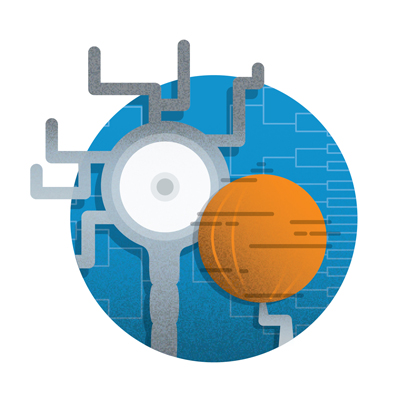Neuron Bracketology: BrainHub Researchers Pit Teams of Neurons Against Each Other To Learn More About How They Work in Teams
By Jocelyn Duffy / 412-268-9982 / jhduffy@andrew.cmu.edu
 As March Madness descends on most of America, neuroscientists at Carnegie Mellon University are engaging in a little bracketology of their own.
As March Madness descends on most of America, neuroscientists at Carnegie Mellon University are engaging in a little bracketology of their own.
The researchers, who are part of Carnegie Mellon’s BrainHubSM research initiative, use an NCAA tournament-style system to pit teams of neurons against one another to determine which squad is best suited to complete a certain job.
It has long been known that neurons in the brain come in different types, varying in their shapes, connections and electrical properties. These different types of neurons team up to help the brain process stimuli from a number of sources.
The lab of Nathan Urban, interim provost and director of CMU’s BrainHub initiative, is working on understanding the specific roles played by different types of neurons and how they work in teams to perform certain computational tasks. The researchers also are trying to determine how many types of neurons are needed to make a functioning brain.
In previous studies, Urban and his collaborators found that no two neurons were exactly alike, and that — much like in sports — diverse teams of neurons perform better than teams with highly similar members.
“A team with all point guards isn’t going to make it to the Final Four. Additionally, any one point guard will perform differently depending on which team he’s on. You need to create a team with quality players in the various roles, and they also need to have a certain chemistry,” Urban said. “Similarly, a diverse group of neurons is much better at performing certain tasks, such as capturing nuanced features of a complex stimuli, than groups of very similar neurons.”
In order to find out which teams of neurons would best represent a given stimulus, they turned to a statistical modeling approach called generalized linear modeling. This approach allows them to model the behavior of individual neurons in a computer and gather statistics about single cells. The computer then generates teams of cells with varying compositions of neurons and pits them against one another in competition to see which team could most accurately recreate a stimulus.
“When we get to the ‘Neuron Final Four,’ we look to see what’s true of these winning teams of neurons,” said Urban, who is also the Dr. Frederick A. Schwertz Distinguished Professor of Life Sciences and a member of the joint CMU/University of Pittsburgh Center for the Neural Basis of Cognition. “What is it that makes these teams outcompete the others?”
The researchers found that most successful neuron teams were made up of neurons that behaved differently, but not differently enough to be considered a random grouping. The most successful teams were the ones that contained neurons that had the right mix of stars and complementary role players — such teams had the flexibility to respond well to a variety of challenges.
The research group plans to continue this work in order to understand the biological mechanisms that give rise to this variability and figure out how the brain “drafts” the right group of neurons into a team that is performing a particular task.